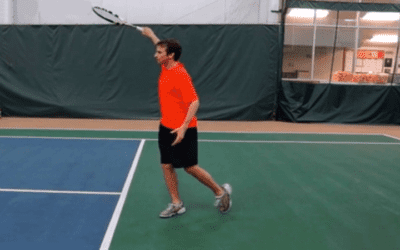What would it take to develop the proper tennis serve technique by using the pinpoint stance?
I am a big proponent of using a platform stance, where you keep your feet solid, then bend your knees and jump to the serve. However, today I will discuss the pinpoint stance, where you move your back foot up before serving.
I have heard many players who feel a better rhythm when they use a pinpoint stance. Hence, I will explain a slightly different version of it, which can help you to improve your serve. In fact, it will help you to develop proper disguise to hit an amazing topspin serve.
Let’s get into a detailed breakdown of what I call a “modified platform stance”.
The Modified Platform Stance

First, you can get in your regular stance. Then, you will move your back foot up so that it stays behind the front foot. I like this stance because it allows you to push off of both feet properly. I also think it can help a player hold their shoulder turn.
Many players face the net when they bring their back foot up. Therefore, they end up losing a lot of disguise and ability to hit topspin. Instead, they hit more slice serves. That is why I recommend not use a regular pinpoint serve stance. The more your back foot comes up, the less hip turn you will have, and the greater chance to hit a slice serve.
Let’s summarize the tennis serve technique on the pinpoint stance. I suggest using a modified platform stance, where your back foot still stays behind the front foot.
This will help you keep that great shoulder turn and disguise. Moreover, it will allow you to push off of both legs. As soon as you bring your back foot up, you will not be able to push off that back leg as well. If you need more rhythm and stability, consider upgrading your tennis serve technique by working on the modified platform stance.
Jeff is a former top 100 ATP player and USTA high performance coach committed to helping players and coaches all over the world improve.
P.S. – Want to take your serve to the next level? Avoid power leaks on your serve with this little known “elbow the enemy” move. Click here to get instant access.



0 Comments